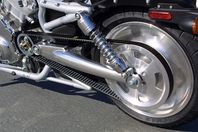Asia
EMEA

LANXESS Canada Contacts
Contact our Sites in Canada
Media Inquiries
General Inquiries
Please click here to e-mail LANXESS Canada with product inquiries and general requests.
Global Press Releases
2011-05-19
Synthetic rubber products under the hood advance mobility
New challenges in “green” cars
New drive concepts in automotive engineering pose new challenges for elastomers, including high resistance to previously uncommon media, such as ethanol, increased demands on flame retardance and, in electric vehicles, high ozone resistance. As a pioneer of synthetic rubber, LANXESS already has a wide range of special-purpose rubber products for technical rubber articles in its portfolio that are capable of cleverly mastering new tasks in the cars of tomorrow.
“Automotive experts are convinced that electric cars will make up a major percentage of our mobility mix in just a few years,” says Dr. Günther Weymans, head of the Technical Rubber Products business unit at LANXESS. “It’s no surprise that rubber articles in this field of application must have different properties from those in cars with a conventional gasoline engine.” The typical gasoline and oil environment for many years required rubber products that displayed only low-volume swelling in nonpolar media. Small, lightweight vehicles with alternative drive systems, however, will likely generate growing demand for synthetic rubber products for critical applications that require long-term stability under high operating temperatures. Another challenge is the high sensitivity of many “classical” rubber raw materials to ozone, which is generated virtually inevitably in the presence of electrically driven units.
Saturated ethylene-propylene-diene monomer rubber grades (EPDM) like Buna EP from LANXESS, for example, are ideally suited to this field of application. Buna EP, a popular material for window and door seals in “traditional” motor vehicles, boasts outstanding resistance to high temperatures and ozone. Another advantage in favor of this synthetic rubber is that it has a lower density than many other rubber raw materials, meaning it can be used to fabricate very lightweight articles. And this, too, contributes to sustainability, because each and every pound saved reduces a vehicle’s energy consumption. What’s more, in the case of electric cars, lower weight translates into greater cruising range.
Another aspect that necessarily plays a key role in the selection of materials for electric vehicles is flame retardance. In the event of fire, caused for instance by a short, hose materials must ensure that the lines maintain their function for a sufficiently long time, and above all pose no additional risks to the driver, such as through toxic smoke. The use of ethylene-vinyl-acetate copolymers (EVM), such as Levapren from LANXESS, can pay off in this case. Levapren contains no halogen and can take up large quantities of inorganic flame retardant. When Levapren compounds burn with other materials in an external flame, only low-density smoke gases evolve; the corrosive hydrogen chloride gas sometimes produced when materials containing chlorine burn is not emitted by EVM copolymers simply by virtue of their chemical makeup.
In vehicles powered by fuel cells, engineers similarly face new challenges when selecting the best materials. Nanoprene, a special-purpose rubber from LANXESS, could help in key applications to enhance the performance of the hydrogen-driven motor vehicles of the future. In the form of an additive, Nanoprene can transport protons through the critical membrane of a fuel cell better than many other materials.
“This illustrates the point well: electric cars are only one example of the new applications in which versatile synthetic rubber products from LANXESS prove successful. Other drive concepts also pose new challenges that only can be mastered with special elastomers,” Weymans says. Take for instance Levatherm F fluoroelastomers from LANXESS with their extraordinary chemical and thermal resistance. Similarly, the hydrogenated nitrile-butadiene rubber (HNBR) products marketed by the Leverkusen-based synthetic rubber specialist under the name Therban prove their worth in the presence of high-powered electrical units characterized by high energy densities and operating temperatures. Therban in rubber articles subject to high dynamic load withstands continuous operating temperatures of up to 160 °C.
Therban grades recently became available at LANXESS that are suitable for contact with biodiesel and high ethanol fuels, and that display even greater aging resistance than partially hydrogenated rubber grades thanks to their fully hydrogenated molecular backbone. In terms of their resistance to various media, these products can even compete with fluoroelastomers in several applications. Today, Therban also is used in tank seals in natural gas-powered vehicles. The HNBR tolerates contact with nonpolar media and reliably holds its own even in the low temperatures occasionally encountered in the presence of liquid or highly compressed gases.
On account of its outstanding resistance to a number of chemicals, Buna EP conquered a new field of application that was highly unusual in the automotive sector a few years ago: hoses that feed urea solutions to the catalytic converter in diesel vehicles with catalytic denitrification systems. Urea can damage several conventional rubber grades; EPDM is much more stable chemically.
“New drive concepts force us to rethink the subject of rubber. That’s a very exciting job for us, because as a pioneer of synthetic rubber and one of the world’s largest synthetic rubber manufacturers, we market not just polymers, but solutions to problems,” Günther Weymans adds. “Our unique wealth of experience helps our customers to make mobility possible today and will continue to do so in the future.”
LANXESS is a leading specialty chemicals company with sales of EUR 7.1 billion in 2010 and currently around 15,500 employees in 30 countries. The company is at present represented at 46 production sites worldwide. The core business of LANXESS is the development, manufacturing and marketing of plastics, rubber, intermediates and specialty chemicals.
- Gallery




